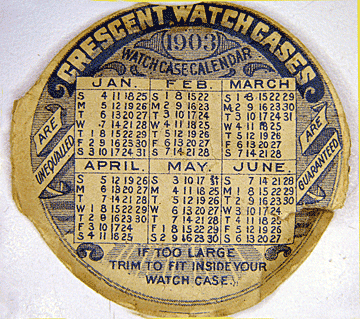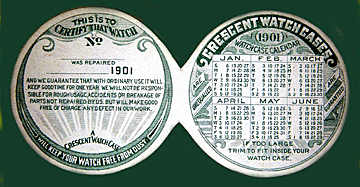Watch Papers Offer More
Than
Protection
by Bob Brooke
 Watch papers have long
been neglected by collectors, but now they’re becoming popular.
Originally used as a packing
between the inner and outer case of a watch to protect its works, they
became keepsakes in the mid-18th century. Women embroidered flower
patterns on silk watch papers and made cutout or pinpricked designs of
hearts, doves, forget-me-nots and wreaths. They also made them of woven
hair or crocheted them from fine silk thread or quilted them.
Hand-stitched monograms in wreaths of laurel or moss roses and
hand-painted watch papers were especially popular. Often early handmade
watch papers took the form of a valentine or birthday greeting or a
memorial for dead loved ones, showing a tombstone shadowed by a weeping
willow. Examples have also been found with the Lord's Prayer in minute
hand-writing and with a miniature map of part of the United States. Watch papers have long
been neglected by collectors, but now they’re becoming popular.
Originally used as a packing
between the inner and outer case of a watch to protect its works, they
became keepsakes in the mid-18th century. Women embroidered flower
patterns on silk watch papers and made cutout or pinpricked designs of
hearts, doves, forget-me-nots and wreaths. They also made them of woven
hair or crocheted them from fine silk thread or quilted them.
Hand-stitched monograms in wreaths of laurel or moss roses and
hand-painted watch papers were especially popular. Often early handmade
watch papers took the form of a valentine or birthday greeting or a
memorial for dead loved ones, showing a tombstone shadowed by a weeping
willow. Examples have also been found with the Lord's Prayer in minute
hand-writing and with a miniature map of part of the United States.
The watch papers which
have become the most popular with today’s collectors are those
engraved papers used as an advertising medium by watchmakers or as
labels are often usually attractive. Many well-known American artists
engraved them so that they may have real esthetic value.
 By the beginning of the
19th century, watchmakers realized they could use small, round papers in
the back of a watch as an advertising medium. It soon became the custom,
when they cleaned and repaired a watch, for watchmakers to insert their own
papers, perhaps showing an engraved scene with their name and the
location of their shops. On the reverse of the paper the watchmaker might note the
price and date of repairs. By the beginning of the
19th century, watchmakers realized they could use small, round papers in
the back of a watch as an advertising medium. It soon became the custom,
when they cleaned and repaired a watch, for watchmakers to insert their own
papers, perhaps showing an engraved scene with their name and the
location of their shops. On the reverse of the paper the watchmaker might note the
price and date of repairs.
You won’t find watch
papers in every old watch, for the tiny papers were easily destroyed,
but there are many watches stored away in collections and safe-deposit
boxes that contain old engraved papers, and many watches contain more
than one paper.
In 1758, Hugh Gaine ran
the first notice of an American watch paper in an ad in a New York
paper. Other engravers followed suit.
Collectors gather watch
papers because of the watchmaker's name or they may be concerned only
with the design of the watch paper and the artist who engraved it. While
every engraved watch paper has the name of the watchmaker or watch
repairman, the beauty of the designs varies. Few engravers marked their
names on their watch papers. Although the designs differ, there are
certain subjects such as hourglasses, Father Time, watches, eagles,
Justice, ships, anchors, draped figures, and cherubs that were the most
popular.
Watch papers were both
printed and engraved on white, cream, buff, orange, blue, green, yellow
or rose paper. Sometimes, engravers printed them in combinations of
colors such as white on silver, gold on blue, blue on gold or red or
green on white. The round papers vary in size from 1 1/2 inches to
21/2 inches in diameter, but the common size seems to be about 2 inches in
diameter. Though watch papers also varied in thickness, the earliest
ones are on thicker and higher-grade paper.
<
Back
to More Antique Spotlights
Next Article >
|
